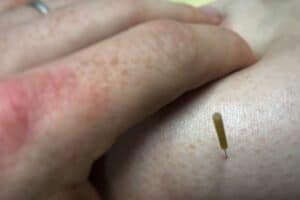Trigger points
Effective treatment of muscle tension and myofascial pain
Dry needling is a targeted technique for treating painful muscle hardening (trigger points). Thin, sterile needles are inserted directly into the affected muscle to relieve tension and promote blood circulation. This method is carried out by specially trained therapists and ideally complements manual trigger point therapy.
Dry needling
Dry needling
How does dry needling work?
The needle stimulation triggers a local muscle twitch - a sign that the muscle is relaxing and its metabolic activity is improving. As a result, pain can often be significantly reduced after just a few sessions.
Advantages of dry needling:
Targeted release of stubborn muscle stiffness
✔ Promotes blood circulation and metabolism in the muscle
✔ Supports the restoration of muscle strength and function
✔ Complements functional training and stretching perfectly
When is dry needling useful?
This method is used in particular for the following complaints:
Chronic muscle tension (e.g. neck, back, shoulders)
✔ Tension headaches & migraines
Tendon irritations such as tennis elbow or runner's knee
✔ Pain caused by poor posture and muscular imbalances
✔ Sports injuries & overuse syndromes
Procedure of the treatment:
- Medical history & examination - Identification of the affected muscles
- Dry needling application - Inserting the needles into the trigger point
- Muscle twitching & relaxation - Signs for the activation of healing
- Functional training & stretching - Support for long-term regeneration
Difference to acupuncture
While acupuncture is based on traditional Chinese medicine, dry needling is a scientifically based method that specifically treats muscular trigger points.
When is dry needling not suitable?
❌ Taking blood thinners
❌ Freshly operated areas
❌ Pregnancy (after consultation with the doctor)
Allergies to nickel or latex
Free yourself from muscle tension
Experience how dry needling specifically relieves pain and improves your mobility. Make an appointment now!
FAQ Dry Needling
Dry needling is a technique in which fine needles are inserted into specific trigger points within the affected muscles. These trigger points are often hardened or tense muscle areas that can cause pain.
Although both techniques use needles, they differ fundamentally in their approach and philosophy. Dry needling is based on Western medical science and focuses on trigger points and muscle tissue, while acupuncture is part of traditional Chinese medicine and stimulates energetic meridians.
Dry needling is often used for the treatment of:
- Muscular trigger points
- Myofascial pain syndromes
- Chronic pain
- Spasticity in neurological patients
- Acute and chronic orthopaedic complaints
The potential benefits of dry needling include
- Pain reduction
- Improving the range of motion
- Reduction of muscle tension
- Acceleration of the healing process for injuries
The therapist carries out a comprehensive assessment and identifies the trigger points to be treated. The needles are then inserted directly into these trigger points. This is often followed by gentle manipulation of the needle to maximize the therapeutic effect.
Some patients experience slight discomfort or muscle twitching when the needle reaches a trigger point. However, most do not feel any significant pain and the discomfort usually subsides quickly.
The most common side effects are
- Temporary pain or tenderness at the injection site
- Slight bleeding or bruising
- Tiredness or general malaise after treatment
Yes, if it is performed by a suitably trained and qualified therapist. Our therapists are specially trained in this technique and use sterile needles to minimize the risk of infection.
Dry needling should be avoided or used with caution under the following conditions:
- Acute infections or skin diseases at the injection site
- Blood clotting disorders or use of anticoagulants
- Severe cardiovascular diseases
- Pregnancy (especially in the first trimester)
- Sensitive or anxious patients who may react strongly to the treatment
Anticoagulants are no longer an absolute contraindication. However, aggravating risk factors must be taken into account:
- Recently initiated medication
- Volatile INR (International Normalized Ratio)
- Intensive sporting activity
- Interdependence with other medications Recommended risk minimization measures include
- the use of acupuncture needles instead of sharpened injection needles and the postneedling compression for 15 seconds.
After the treatment you should:
- Drink plenty of water to promote healing.
- Avoid excessive strain on the treated muscle groups.
- Watch out for unusual symptoms such as severe pain or swelling and contact your therapist if necessary.
The number of treatments required varies depending on the type and severity of the symptoms. Some patients experience an improvement after just a few sessions, while others require several treatments over weeks or months.
Please contact our practice by telephone or via our website to make an appointment. Our team will be happy to answer any further questions you may have and to make an appointment.

